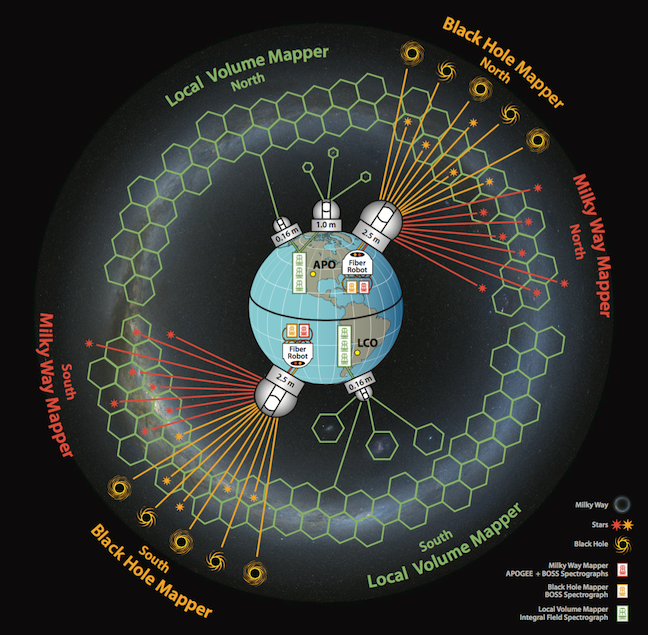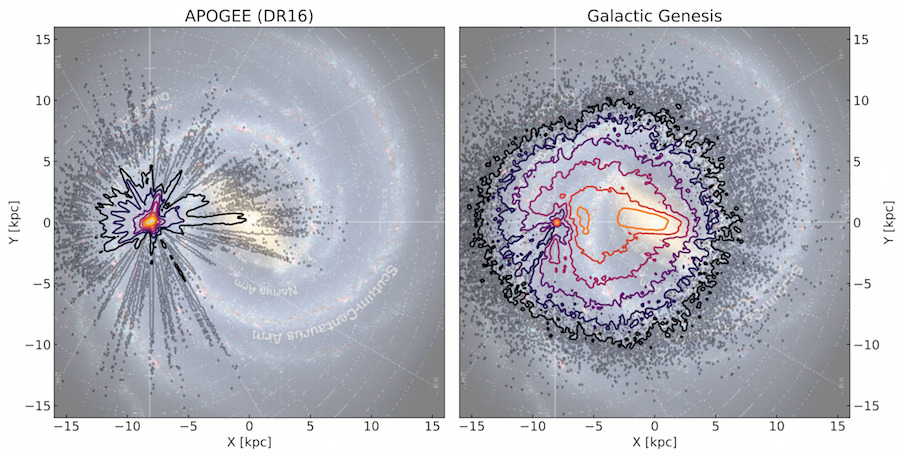Tau.Neutrino said:
First light on a next-gen astronomical survey toward a new understanding of the cosmos
The Sloan Digital Sky Survey’s fifth generation collected its very first observations of the cosmos at 1:47 a.m. on October 24, 2020. This groundbreaking all-sky survey will bolster our understanding of the formation and evolution of galaxies—including our own Milky Way—and the supermassive black holes that lurk at their centers.
more…
Thanks for that. I know of SDSS-IV, but SDSS-V is completely new to me.
The latest data release is data release 16, the fourth data release from SDSS-IV. DR16 contains SDSS observations through August 2018.
Details here: https://www.sdss.org/dr16/
DR16 includes the latest and final data release of optical spectra from the SDSS component extended Baryon Oscillation Spectroscopic Survey (eBOSS), and more. eBOSS has been a bleedin’ marvellous project.
On SDSS-V, start with https://www.sdss.org/future/
Lots of good links from that page.
SDSS-V: Pioneering Panoptic Spectroscopy
Multi-Object Spectroscopy: optical & near-IR, all-sky, multi-epoch
Integral Field Spectroscopy: optical, 2500 deg^2, ultra wide-field
SDSS-V will be carried out in both hemispheres, at Apache Point Observatory (APO) in the USA and Las Campanas Observatory (LCO) in Chile. Multi-object fiber spectroscopy will be obtained with two 2.5m telescopes, each feeding a near-infrared APOGEE spectrograph and an optical BOSS spectrograph, for the Milky Way Mapper and Black Hole Mapper programs. The Local Volume Mapper will make use of smaller telescopes to perform its optical integral-field spectroscopy.

The Milky Way Mapper (MWM) will target 4-5 million stars across the Milky Way, collecting infrared spectra with an APOGEE spectrograph and/or optical spectra with a BOSS spectrograph. The MWM seeks to understand the evolution of the Milky Way, the physics of its stars and interstellar medium, and the architecture of multiple-star and planetary systems.
The Black Hole Mapper (BHM) will target over 400,000 sources, primarily black holes, with a BOSS optical spectrograph. Many of these will be observed numerous times, with the goal of measuring black hole masses, probing black hole growth across cosmic time, and characterizing the X-ray sky.
The Local Volume Mapper (LVM) will observe the interstellar medium and stellar populations in the Milky Way and several local galaxies, collecting more than 25 million contiguous spectra over 2,500 square degrees on the sky. The LVM will use new integral-field spectrographs to explore the physics of star formation and the interactions between stars and the interstellar medium.
SDSS-V, like previous SDSS surveys, will remain committed to making its data publicly available in a format that is helpful to a broad range of users, from beginner students to both amateur and professional astronomers. Without federal or other large-scale funding, this commitment is not possible without membership contributions. SDSS-V is currently actively seeking funding from partners.
This bit is exciting. The DR16 Apogee data mapped spectra for several percent of the Milky Way (left). SDSS-V aims to map spectra for considerably more than half of the entire Milky Way (right).


